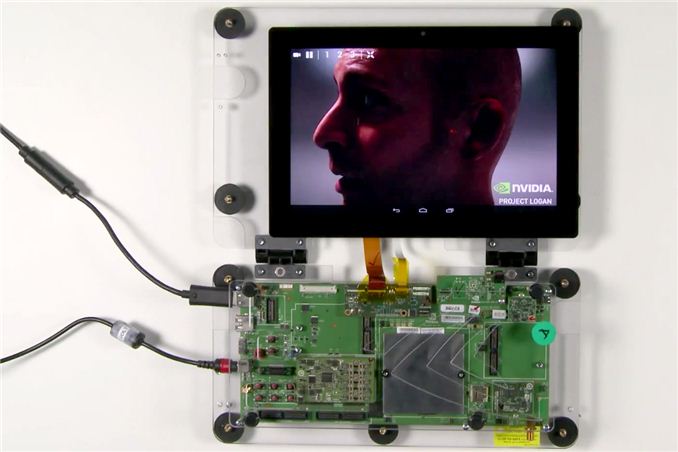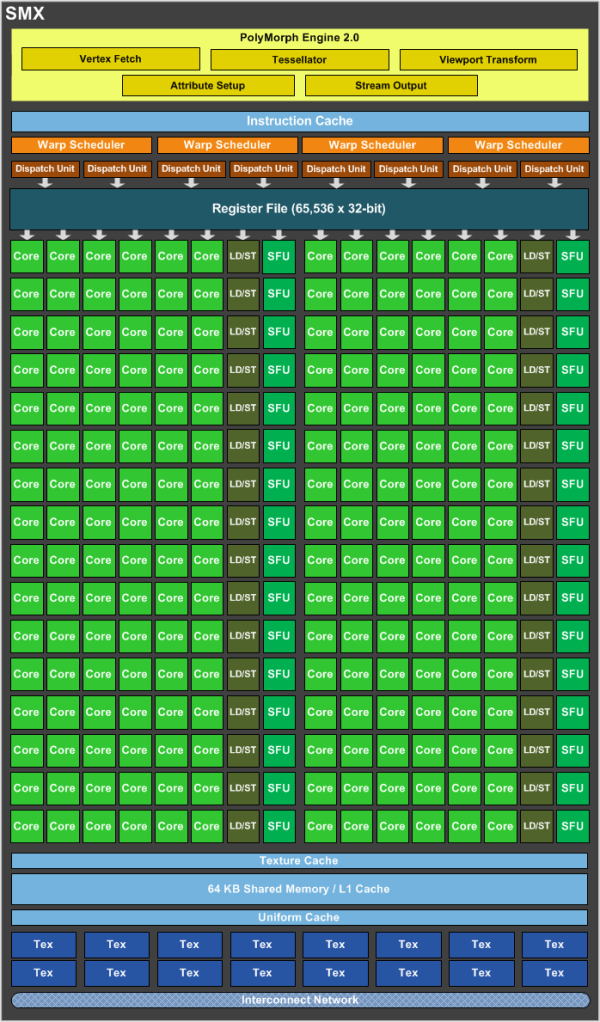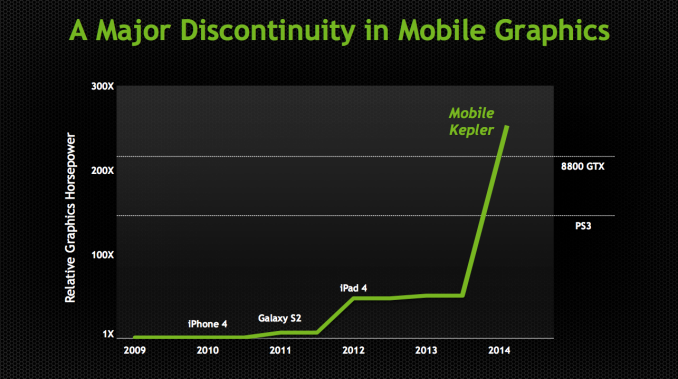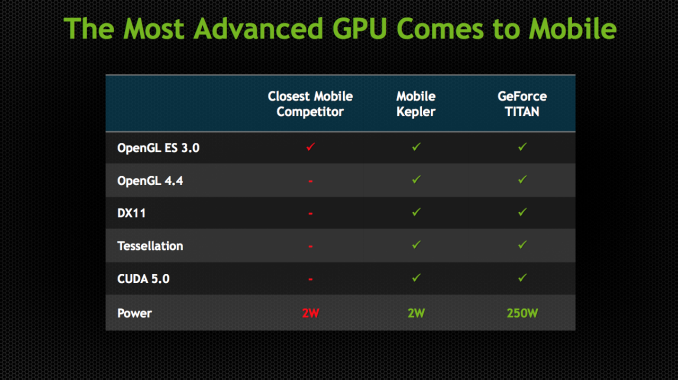NVIDIA Demonstrates Logan SoC: < 1W Kepler, Shipping in 1H 2014, More Energy Efficient than A6X?
by Anand Lal Shimpi on July 24, 2013 9:00 AM EST
Ever since its arrival in the ultra mobile space, NVIDIA hasn't really flexed its GPU muscle. The Tegra GPUs we've seen thus far have been ok at best, and in serious need of improvement at worst. NVIDIA often blamed an immature OEM ecosystem unwilling to pay for the sort of large die SoCs necessary in order to bring a high-performance GPU to market. Thankfully, that's all changing. Earlier this year NVIDIA laid out its mobile SoC roadmap through 2015, including the 2014 release of Project Logan - the first NVIDIA ultra mobile SoC to feature a Kepler GPU. Yesterday in a private event at Siggraph, NVIDIA demonstrated functional Logan silicon for the very first time.
NVIDIA got Logan silicon back from the fabs around 3 weeks ago, making it almost certain that we're dealing with some form of 28nm silicon here and not early 20nm samples.
NVIDIA isn't talking about CPU cores, but it's safe to assume that Logan will be another 4+1 arrangement of cores - likely still based on ARM's Cortex A15 IP (but perhaps a newer revision of the core). On the GPU front, NVIDIA confirmed our earlier speculation that Logan includes a single Kepler SMX:
One Kepler SMX features 192 CUDA cores. NVIDIA isn't talking about shipping GPU frequencies either, but it did provide this chart to put Logan's GPU capabilities into perspective:
Don't get too excited as we're looking at a comparison of GFLOPS and not game performance, but the peak theoretical ALU bound performance of mobile Kepler should exceed that of a Playstation 3 or GeForce 8800 GTX (memory bandwidth is another story however). If we look closely at NVIDIA's chart and compare mobile Kepler to the iPad 4, we get a better idea of what sort of clock speeds NVIDIA would need to attain this level of performance. Doing some quick Photoshop estimation it looks like NVIDIA is claiming mobile Kepler has somewhere around 5.2x the FP power of the PowerVR SGX 554MP4 in the iPad 4 (76.8 GFLOPS). That works out to be right around 400 GFLOPS. With a 192 core implementation of Kepler, you get 2 FLOPS per core or 384 FLOPS per cycle. To hit 400 GFLOPS you'd need to clock the mobile Kepler GPU at roughly 1GHz. That's certainly doable from an architectural standpoint (although we've never seen it done on any low power 28nm process), but it's probably a bit too high for something like a smartphone.
NVIDIA didn't want to talk frequencies but they did tell me that we might see something this fast in some sort of a tablet. I suspect that most implementations will be clocked significantly lower. Even at half the frequency though, we're still talking about roughly Playstation 3 levels of FP power out of a mobile SoC. We know nothing of Logan's memory subsystem, which obviously plays a major role in real world gaming performance but there's no getting around the fact that Logan's Kepler implementation means serious business. For years we've lamented NVIDIA's mobile GPUs, Logan looks like it's finally going to change that.
API Support and Live Demos
Unlike previous Tegra GPUs, Kepler is a fully unified architecture and OpenGL ES 3.0, OpenGL 4.4 and DirectX 11 compliant. The API compliance alone is a huge step forward for NVIDIA. It's also a big one for game developers looking to move more seriously into mobile. Epic's Tim Sweeney even did a blog post for NVIDIA talking about Logan's implementation of Kepler and how it brings feature parity between PCs, next-gen consoles and mobile platforms. NVIDIA responded in kind by running some Unreal Engine 4 demos on Android on a Logan test platform. That's really the big story behind all of this. With Logan, NVIDIA will bring its mobile GPUs up to feature parity with what it's shipping in the PC market. Game developers looking to port games between console, PC, tablet and smartphone should have an easier job of doing that if all platforms supported the same APIs. Logan will take NVIDIA from being very behind in API support (with no OpenGL ES 3.0 support) to the head of the class.
NVIDIA took its Ira demo, originally run on a Titan at GTC 2013, and got it up and running on a Logan development board. Ira did need some work to make the transition to mobile. The skin shaders were simplified, smaller textures are used and the rendering resolution is dropped to 1080p. NVIDIA claims this demo was done in a 2 - 3W power envelope.
The next demo is called Island and was originally shown on a Fermi desktop part. Running on Logan/mobile Kepler, this demo shows OpenGL 4.3 and hardware tessellation working.
The development board does feature a large heatspreader, but that's not too unusual for early silicon just out of bring up. Logan's package size should be comparable to Tegra 4, although the die size will clearly be larger. The dev board is running Android and is connected to a 10.1-inch 1920 x 1200 touchscreen.













141 Comments
View All Comments
mwildtech - Wednesday, July 24, 2013 - link
Mother of God....kukarachee - Wednesday, July 24, 2013 - link
True enough and agreed. Not really that impressive.More so considering nvidia's long history of misrepresenting power consumption and performance on upcoming parts. No doubt by the time we see this available and shipping there will be much better SOC options from the likes of Qualcomm etc.
Disappointing.
mmrezaie - Wednesday, July 24, 2013 - link
you have issues, man!dragonsqrrl - Wednesday, July 24, 2013 - link
haters gonna hateEWP - Wednesday, July 24, 2013 - link
Well said. In the mobile space nVidia has consistently fallen far short of their claims. Their CEO jus seems like such a blowhard with his long list of outrageous claims.kukarachee - Thursday, July 25, 2013 - link
Yes, we are almost certainly going to see another Tegra 4 play out here. Far over-promise and massively under-deliver.Tegra 4 has been an enormous bomb with sparse design wins to the point they threw most of what they had in a handheld Android gaming device that had to receive a $100 price cut before even hitting the market and it -STILL- is not selling with little interest in Shield, extending the failure of Tegra 4.
Tegra 4 has been crushed in the market by Samsung and Qualcomm and by the time we even see this part actually -available *AND* shipping- it will be already be old news like Tegra 4 was. Never mind that nvidia is getting their butt kicked in design wins for their SOCs by the Qualcomm monolith. Likely due to the failure and issues with Tegra 3 for units such as the Nexus which ditched nvidia for Qualcomm.
Tegra 4 is in nothing but a crappy over-heating tablet and a failed handheld gaming device sold by nvidia themselves. I expect the same for this part if they again can't manage to deliver on their promises -AS WELL- as deliver on time. Two things they have yet to manage...
Yojimbo - Friday, July 26, 2013 - link
Throughout its history, Nvidia has generally operated like a locomotive. Whenever they have entered a new sector they make a splash by making promises, and in the first couple generations they come up short of their promises. But with successive generations they've gained ground, and executed more consistently than their competitors, until they are among the leaders of the sector. It happened with desktop 3d graphics and with mainboard chipsets. There is stiff competition in the mobile SOC space, but I wouldn't be so quick to dismiss them there, either.michael2k - Friday, July 26, 2013 - link
Yet by your admission there is every reason to dismiss them until they catch up. The problem is that they are competing against three companies that have consistently executed for years now; PowerVR, Qualcomm, ARM, and Apple. They have to consistently outperform Apple and PowerVR if they wish to gain Apple's business, they have to consistently outperform ARM and PowerVR to gain Qualcomm's business, and they have done neither yet.Yojimbo - Friday, July 26, 2013 - link
My post was a reply to kukarachee's post. He is dismissing the announced generation out-of-hand because of their past relative performance in the sector. The important distinction here is that kukarachee is attempting to make a prediction about a future iteration based solely on Nvidia's previous results in this sector. My argument is that there is NOT every reason to dismiss Nvidia, because they have a track record of succeeding at playing that same game of catch up. I will admit that it's two conflicting track records, and one must decide which one applies in this instance, but I will certainly not admit that there is every reason to dismiss them until they catch up. Whichever track record you find more appropriate to pay attention to is your own choice, however.michael2k - Saturday, July 27, 2013 - link
There's no indication they've caught up yet, however. The PowerVR 6 was demonstrated at GDC, earlier this April, and is expected to be out shortly. Logan won't be out until next year, which means by definition it is going to be behind.